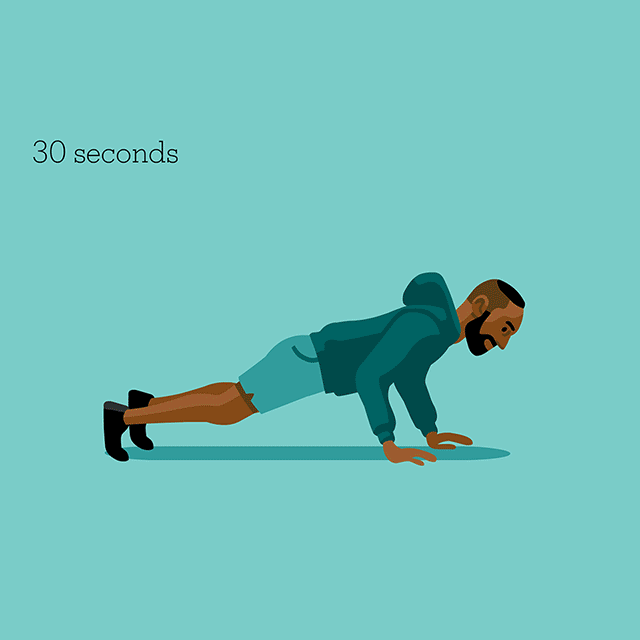
HIIT (high-intensity interval training) workouts are a popular way to lose weight and tone muscles. Although this method is very effective, it requires a lot of dedication. This type exercise is very intense and only involves a handful of exercises. A good DVD or fitness DVD is a must if you want the best out of this workout.
HIIT requires that you change the intensity of your workouts every few working days. It's a great way for you to burn calories. But it's crucial that you follow a HIIT program. HIIT programs usually start with low-intensity exercise, but you can also begin with a more advanced version if this is something you have never done before. It is possible to make the most HIIT workouts, but it is important that you read the instructions so you can get the most out your fitness program.

Warming up before you start a HIIT program is important. Using the standard stretching protocol, you'll increase your heart rate and move your muscles before tackling the toughest moves. You might have questions if you've never tried HIIT before. Here are some things you can do to prepare. The best HIIT workout involves using your whole body.
You should pick an exercise that is suitable for you, even if you are not a beginner. Bodyweight exercises like burpees and squats are an excellent place to start. You can start HIIT by joining a gym or using free weights. You can find many videos on YouTube and social media. This type workout will make you feel like an expert in no time.
You don't need a gym to do HIIT. All you need is a little space and some exercise equipment. Beginners should aim to maintain a one-to-4 ratio between work and rest. You can increase the number or intensity of your exercises depending on your level of fitness. You can do as many sessions as you like, or less, depending on your comfort level.

HIIT can be easily integrated into any exercise program. You can start with a squat. Start with your feet parallel to your floor. Keep your elbows and knees bent. Your body weight should be lowered towards the floor. Keep your spine neutral and engage your core as you lower yourself. Next, lift your arms to touch the opposite shoulder. Return to the beginning position.
A HIIT workout can be used as a supplement to your regular strength training routine. Intensive exercises can be used to lose fat and tone your muscles. Using a HIIT workout can help you burn calories and build muscle at the same time. Its duration depends on your fitness level and what you're trying to achieve. You can combine strength training with HIIT to achieve maximum results.
FAQ
How much should I weight for my height and age? BMI calculator and chart
A body mass index calculator (BMI) is the best way to find out how much weight you should lose. The range of a healthy BMI is between 18.5- 24.9. Weight loss is possible if you aim to lose approximately 10 pounds per week. Enter your height and weight to calculate your BMI.
This BMI chart can help you find out if or not you are obese.
Are there 5 ways to have a healthy lifestyle?
Healthy living means eating right, exercising regularly and getting enough sleep. It also involves managing stress and having fun. Avoiding sugar and processed foods is key to eating well. Exercise strengthens your muscles and helps you lose calories. Getting enough sleep improves memory and concentration. Stress management can reduce anxiety and depression. And finally, having fun keeps us young and vibrant.
Does being cold give you a weak immune system?
According to some, there are two types: people who love winter or those who hate it. You might wonder why you feel so miserable in the cold, no matter how much you love or hate winter.
The answer lies in the fact that our bodies are designed to function best during warm weather. Because of this, our bodies evolved to thrive and survive in hot climates.
Now, however, we live in a completely different environment to how our ancestors lived. We spend more time indoors, are exposed to extreme temperatures (cold/heat), and eat processed food rather than fresh.
As a result, our bodies aren't used to such extremes anymore. So, when we do venture outside, we often feel exhausted, sluggish, or even sick.
However, there are some ways to reduce these effects. Staying hydrated is one way to combat this. Hydration is key to keeping your body well hydrated, flushing out toxins and keeping your system healthy.
Also, ensure you eat healthy food. Consuming healthy food helps maintain your body's optimal temperature. This is especially true for people who spend long hours indoors.
Consider taking a few moments each morning to meditate. Meditation helps to calm your mind and body which can make it easier to deal stress and illness.
Is being cold good for your immune system.
Cold weather can cause a decline in your immune system. Your body produces fewer white blood cell which fight infection. However, being cold also makes you feel better because your body releases endorphins into your brain which reduce pain.
How often should i exercise?
It is important to exercise for a healthy lifestyle. There is no time limit on how much you should exercise. It is important to find something that you enjoy and stay with it.
You should aim to do 20-30 minutes of moderate intensity exercise three times per week. Moderate intensity means you'll still be breathing hard after you've finished. This type workout burns about 300 calories.
If you prefer to walk, go for 10 minute walks four days a week. Walking is low-impact, easy on your joints, and it's also very gentle.
Jogging is an alternative to running. You can do it for as little as 15 minutes each day. Running can help you burn calories and to tone your muscles.
You can start slow if you're new to exercise. Start with just 5 minutes of cardio a few times a week. Gradually increase duration until you achieve your goal.
Statistics
- WHO recommends reducing saturated fats to less than 10% of total energy intake; reducing trans-fats to less than 1% of total energy intake; and replacing both saturated fats and trans-fats to unsaturated fats. (who.int)
- Extra virgin olive oil may benefit heart health, as people who consume it have a lower risk for dying from heart attacks and strokes according to some evidence (57Trusted Source (healthline.com)
- In both adults and children, the intake of free sugars should be reduced to less than 10% of total energy intake. (who.int)
- According to the 2020 Dietary Guidelines for Americans, a balanced diet high in fruits and vegetables, lean protein, low-fat dairy and whole grains is needed for optimal energy. (mayoclinichealthsystem.org)
External Links
How To
What does the "vitamins” word mean?
Vitamins are organic compounds that can be found in foods. Vitamins are essential for our bodies to absorb nutrients from the foods we eat. Vitamins are not made by the body, so they must be obtained through food.
There are two types of vitamins: water soluble and fat soluble. Water soluble vitamins dissolve easily in water. You can find vitamin C,B1 or thiamine, B2 or riboflavin and B3 or niacin, B3/niacin, B6/pyridoxine, folic Acid, biotin and pantothenic Acid as examples. Fat soluble vitamins are stored in the liver and fatty tissue. Examples include vitamin D, E, K, A, and beta carotene.
Vitamins are classified according to their biological activity. There are eight major categories of vitamins.
-
A – Essential for normal growth, and the maintenance of good health.
-
C - essential for nerve function and energy generation.
-
D - Essential for healthy teeth and bones.
-
E is required for good vision and reproduction.
-
K - essential for healthy muscles, nerves, and bones.
-
P - essential for strong bones, teeth and tendons
-
Q - Aids in digestion and absorption.
-
R - Red blood cells are made from red blood cells.
The recommended daily allowance of vitamins (RDA), varies according to age, gender, physical condition, and other factors. The U.S. Food and Drug Administration has established the RDA values.
For adults over 19 years, the RDA is 400 mg per day for vitamin A. For fetal development, pregnant women need 600 mg per day. Children ages 1-8 require 900 micrograms per day. Infants under one year of age require 700 micrograms per day, but this amount decreases to 500 micrograms per day between 9 months and 12 months of age.
Children ages 1-18years who are obese need 800 micrograms per day while those who are overweight need 1000 micrograms per day and children who are underweight need 1200 micrograms per day to meet their nutritional needs.
Children 4-8 years old who have anemia must consume 2200 micrograms of Vitamin C daily.
2000 micrograms is the minimum daily intake for adults over 50 years old to maintain good health. Mothers who are pregnant, nursing, or have a high nutrient need will require 3000 micrograms a day.
Adults over 70 require 1500 micrograms each day, since they lose around 10% of their muscle mass every decade.
Women who have been pregnant or are lactating require more than the RDA. Pregnant and breastfeeding women require 4000 micrograms each day during pregnancy and 2500 Micrograms each day after delivery. Breastfeeding mothers need to consume 5000 micrograms every day when breastmilk has been produced.